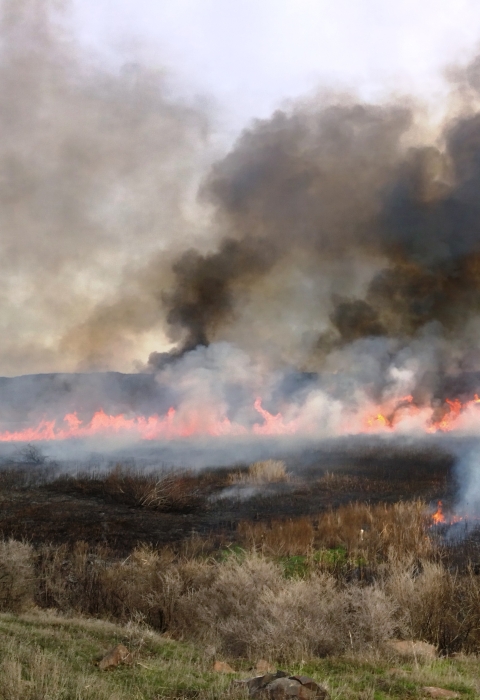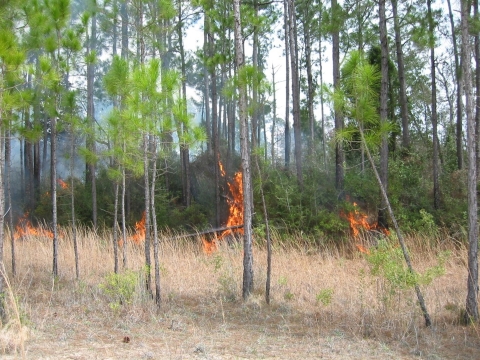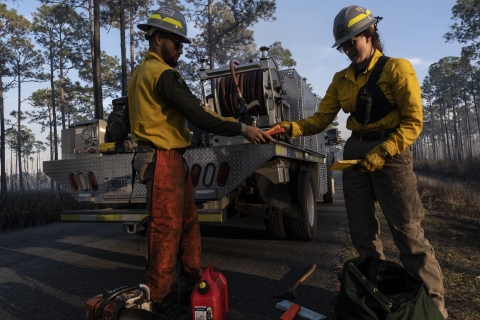What We Do
Our Services
Eighty percent of Service lands, from marsh to forest to prairie, evolved with fire and depend on periodic fire to remain productive wildlife habitat. Fire is a vital conservation tool.
The Service’s fire management program has three main areas of focus:
- fuels management
- wildfire management
- wildfire prevention
By the Numbers
- 450,000 acres burn in wildfires annually
- 350,000 acres treated with prescribed fire annually
- 80% of U.S. Fish and Wildlife Service lands include fire-adapted ecosystems
- 357 U.S Fish and Wildlife Service fire management professionals
Our Priorities
The priorities for the Service’s fuels management program are:
- planning prescribed burns strategically to lessen the threat of wildfire and minimize risks to communities
- applying healthy fire to Service lands to improve habitat for threatened and endangered species and support efforts to recover or avoid listing other vulnerable wildlife species
- investing in fuels treatment projects to reduce costs of wildfire suppression and rehabilitation
- maintaining previously completed fuels-reduction projects
- leveraging funding sources and partnerships
- enhancing and promoting safety and security on Service-managed lands
Work With Us
Wildland Firefighting… Not Your Ordinary Job
Working in fire for the U.S. Fish and Wildlife Service is unlike any other wildland fire position you’ve ever had. Among all the Department of the Interior agencies, we are the only agency whose mission focuses solely on the conservation, protection, and enhancement of fish, wildlife, plants, and their habitat. To adequately protect wildlife species and their habitat, we strategically apply prescribed fire across a variety of landscapes which rely on periodic fire for ecological balance. Of all the prescribed fire acres applied across the country, our fire program applies 50% of them (when combining all the Department of the Interior agency acres). When fire season hits, our fire personnel support suppression efforts across the country, traveling to areas many people never get to see.
A prescribed burn is the controlled use of fire to restore wildlife habitat, reduce wildfire risk, or achieve other habitat management goals. We have been using prescribed burn techniques to improve species habitat since the 1930s.
Learn more about prescribed burn area.
As a smaller wildland fire agency, we have the ability to create an inclusive, welcoming fire family that is perfect for those looking to start their fire careers, spend their entire career, or simply find a place where they belong. We can’t wait to work alongside you soon!
For more information about recruitment and our fire program, please see our recruitment rack card (PDF) or Keeping Fire on Our Side (PDF) brochure
Taking care of our own
- Competitive pay and opportunity for full federal benefits
- Public Service Loan Forgiveness eligibility
- Retirement eligible after 20 years of service
Eligibility
- No experience necessary for entry level positions
- Candidates must be U.S. citizens or nationals
- High school diploma or GED
- Must be 18-37 years old at the time of hire—exceptions may apply
Applying for a Fire Job on USAJobs
Applying for a fire job can sometimes be confusing and cumbersome. Luckily, The National Interagency Fire Center has created these helpful video clips to assist with the application process.
How to Create a USAJobs Account and Login
How to Build a Government Resume for USAJobs
How to Apply and Upload Documents on USAJobs
How to Personalize and Save a USAJobs search
Navigating Federal Benefits and Human Resources
Social Media
Not only do our national fire program social media pages have a lot of current information, we also advertise vacancies on them. Like and follow our Facebook and Twitter pages to stay updated on what’s open for application!
We also have some great #FireHireTips on what to do, and what not to do, on our social media pages.
- #FireHireTips - Account Setup
- #FireHireTips - Resume Builder
- #FireHireTips - Resume Length
- #FireHireTips - Req’d Docs
- #FireHireTips - Search for Vacancies
- #FireHireTips - Optimize Your Application
- #FireHireTips - Age Requirement
- #FireHireTips - Account Setup
- #FireHireTips - Resume Builder
- #FireHireTips - Resume Length
- #FireHireTips - Req'd Docs
- #FireHireTips - Search for Vacancies
- #FireHireTips - Optimize Your Application
- #FireHireTips -Age Requirement
Helpful Links


